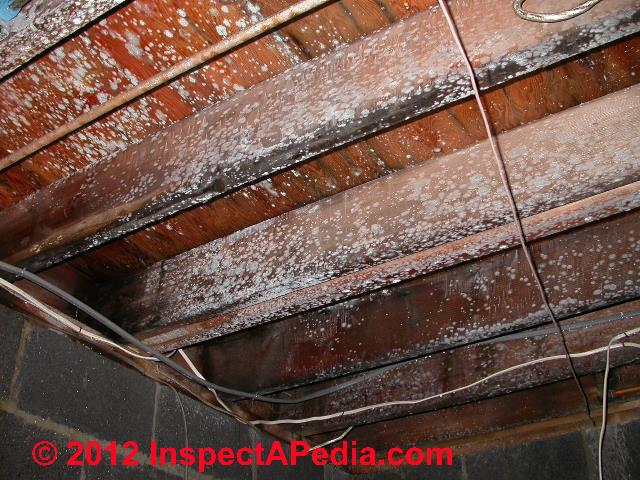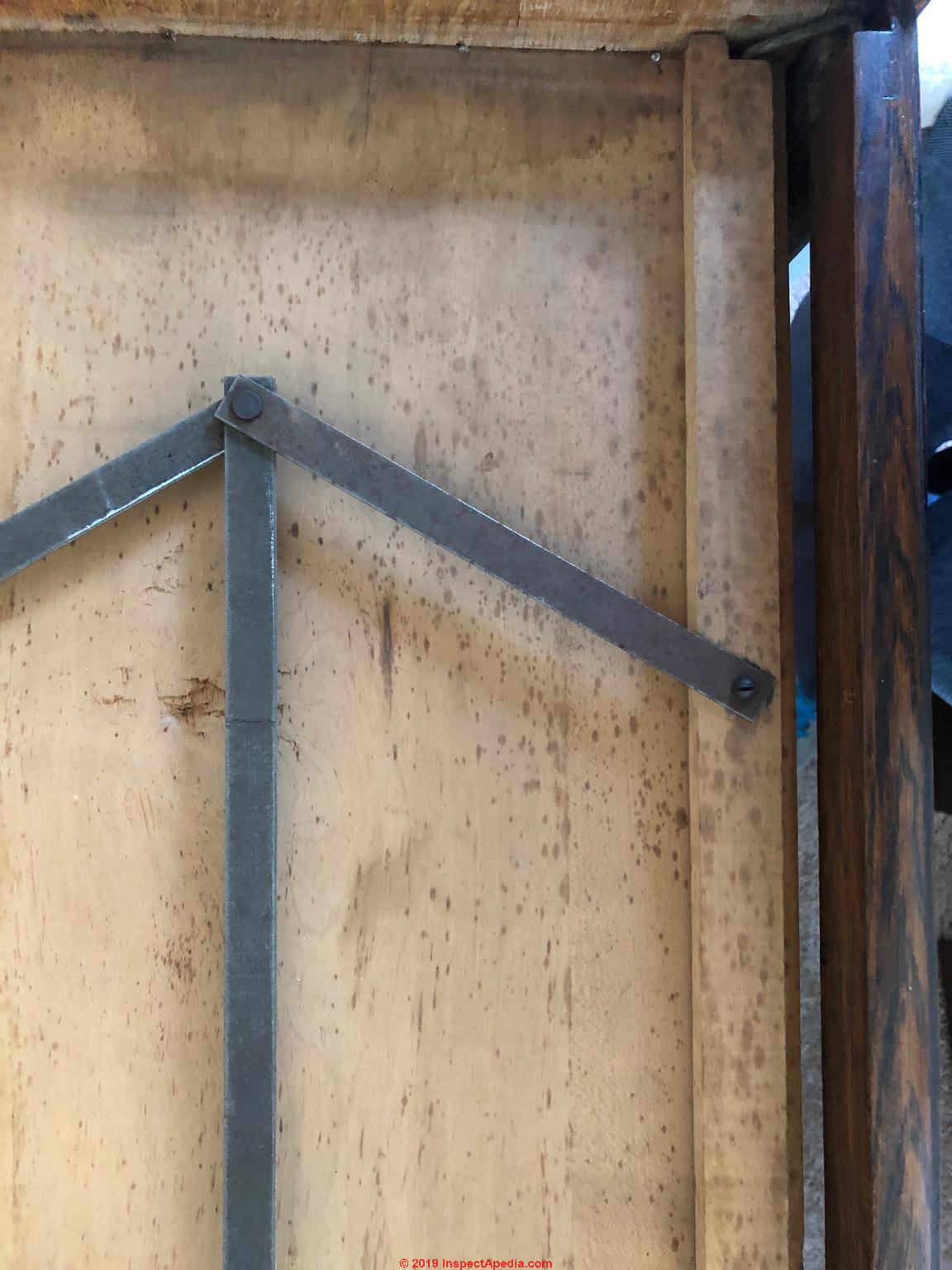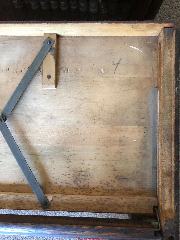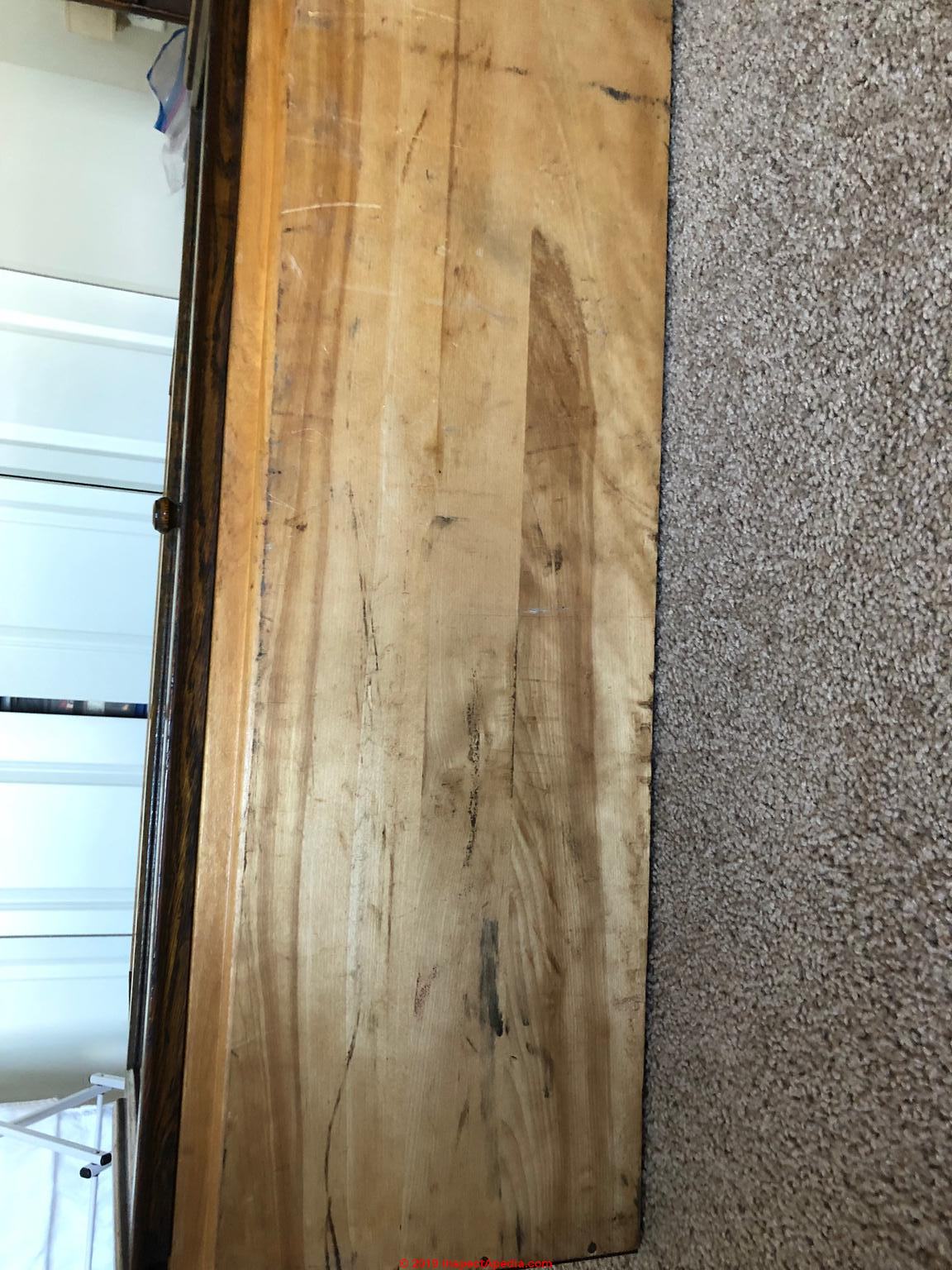 Q&A on How to Clean or Remove Toxic Mold
Q&A on How to Clean or Remove Toxic Mold
Owner/Occupant's Mold Remediation FAQs
- POST a QUESTION or COMMENT about the best procedures to get rid of mold and mold smells in buildings
Questions & answers about cleaning up harmful mold in or on buildings.
This article series describes how toxic or allergenic mold is removed from buildings - mold cleanup, or mold remediation.
Page top photo: extensive mold contamination of floor joists and subflooring over a wet basement inspected by the author - DF.
InspectAPedia tolerates no conflicts of interest. We have no relationship with advertisers, products, or services discussed at this website.
- Daniel Friedman, Publisher/Editor/Author - See WHO ARE WE?
How to Clean or Remove Mold, Moldy Debris, Other Indoor Environmental Contaminants - a Homeowner's Guide
 These questions & answers about how to clean up mold contamination were posted originally
These questions & answers about how to clean up mold contamination were posted originally
at MOLD CLEANUP GUIDE- HOW TO GET RID OF MOLD - please be sure to review the advice given there.
Is Lysol disinfectant a good mold cleaner for my moldy bookcase?
Do you think Lysol disinfect is as good as any other household cleaning product for the barrister bookcase cleaning process you recommend?
Also, how to address concerns about using a web product on unfinished wood and being confident is has adequately dried before sealing it? On 2019-05-09 1 by Anonymous
Reply by (mod) - Any household cleaner is fine for removing mold.
Any household cleaner is fine for removing mold.
I like to spray shellac on the previously uncoated hidden surfaces to help retard mold growth in the future - should the area be moist
but Remember that if you are going to paint with a sealant the surfaces have to be dry AND any soapy residue removed.
You can use a pin type moisture meter to check dryness.
See MOISTURE METER CHOICES
Jeffrey Whitmer said: where can I take classes on mold remediation
I'd be eager to take some mold remediation classes. Where might I start looking?
Reply by (mod) -
Jeff weekend and longer mold remediation courses are thick around us, with varying credentials, including by mail. Any education will be helpful but watch out for courses that really are biased towards selling a particular method, tool, product, or franchise - such classes may fail to give a fair breadth of view of the topic.
Take a look at the curriculum of any course you are thinking of taking.
Watch out also for fundamental mistaken approaches such as "killing mold" or "ozone mold treatments". The basic correct for large areas of mold contamination is to *remove* the mold, clean the remaining surfaces, and fix the cause of the problem.
Mold Removal said: "cleaning" mold and "killing" mold are 2 separate objectives.
Good to mention that in mold remediation, "cleaning" mold and "killing" mold are 2 separate objectives.
While bleach may be good to clean mold, killing mold is better done with an anti-microbial like Microban or equivalent product. Do make a not though, there are several different types of Microban ranging from germicide, fungicide, mildewcide and then some.
Selecting the right product is very important to successful mold removal as well as prevention. 5/30/14
Reply by (mod)
Thank you for commenting.
Interested readers, for an unbiased expert opinion on this, please see MOLD KILLING GUIDE
My HVAC system is mold-contaminated: what do I do now to be sure it's handled right?
After experiencing constant congestion, joint pain,headaches, burning and runny eyes, and even a trip to the ER due to a severe asthma attack 3 months after moving into my new apartment,
I decided to check the air filter in my HVAC system and discovered large amounts of dry black mold growing on the drywall, cement floor, and plastic pipes behind and around the water heater and HVAC system in the mechanical closet of my apartment. I immediately notified the property manager who initially wanted maintenance to clean the surface.
I said "NO WAY, don't touch it" and insisted on professional mold removal specialists to fix the problem, and her regional mgr agreed. I have been out of my apt for a week while the mold is hopefully removed. However, I am concerned that the removal methods being performed are inadequate.
Apparently, they replaced the drywall and the water heater, spayed behind the affected area, used an air scrubber, and will be cleaning the vents. After which I am told an air quality tester will test my apt and I can move back in on the same day, which I think is odd.
Are the test results instant? I have gone by and looked in the window and have never seen any containment plastic.
I asked how they intend to clean the rest of my apartment since spores have likely spread everywhere due to the location of the mold in and around the HVAC system. Should they also replace the HVAC system, including the ducts, vents and the outside Unit?
Should my whole apartment be repainted? What about my couch and mattress? I was told they will pay to have my clothes and bed comforter dry cleaned but is that enough?
I'm very concerned since my health is already compromised.
While my headaches and burning, watery eyes have stopped now that I am out of my apartment, I'm still terribly congested and have difficulty breathing
. I honestly think they are skipping necessary steps in order to conceal the problem. My apt is located next to leasing office, mailboxes, pool, and is 1st apt on tour path for prospect tenants. Help! - On 2012-09-0 by Elisa in Atlanta
Reply by (mod)
Start by getting advice from your doctor, then you'll want a competent onsite inspection to help decide what work is needed.
Take a look at
- ENVIRONMENTAL INSPECTORS & TESTING SERVICES
- MOLD DOCTORS - ENVIRONMENTAL MEDICINE
- MOLD CLEANUP COMPANIES
We are not sure if this is mold in our house - can there be invisible mold in the carpets?
I have found mold through the house I am living in, and I have the symptoms of a mold sensitive person.
We have lifted up the carpets and while we can't "see" any mold on the carpet, the chipboard underneath the carpet is mostly all a dark almost black colour and has small white spots on this dark colouration.
We are not sure if this is mold?
My Dad thinks the white tiny dots are paint spots but in some areas the white little spots are numerous and very close together and in others they are less visible. My Dad thinks the darkness on most of the chipboard is also not mold and is just stains from dirt or water before the chipboard was covered with carpet.
To me it looks like a mold growth as to the edges of where the darkness is you can see blotch shapes as if it is/has been alive and moving. My Dad has tried scrubbing the surface with vinegar and water but it the markings don't seem to change, he thinks this is another sign that it is not mold. Does all mold change/go away with rigorous scrubbing? Can you provide any advice on if this sounds like mold?
If it does sound like mold is it possible to remove it from chipboard? Also, if it is mold is it likely that the carpet is also infected, even though no mold is "visible"? Any assistance will be greatly appreciated! Thank you very much :-) - On 2012-03-07 by Rachel
Reply by (mod) -
Rachel, I can suggest three articles that should be quite helpful in deciding if you're confronted with a building mold problem: see
MOLD APPEARANCE - STUFF THAT IS NOT MOLDMOLD APPEARANCE on VARIOUS SURFACES photo guide to what mold looks like growing on more than 100 different building surfaces
MOLD APPEARANCE - WHAT MOLD LOOKS LIKE - what toxic black mold or other indoor mold looks like in buildings.
and in deciding if what you have observed or experienced seems to justify bringing in a competent expert,
see MOLD / ENVIRONMENTAL EXPERT, HIRE ?
- all of these article titles are found at the bottom of this page.
Mold can be removed from hard surfaces using normal household cleaning methods; mold on drywall, or a flooded carpet, are discarded. But I would not recommend any costly steps before you are confident you know what's going on in the building.
What's the most effective way to clean/remove the mold?
We are about to close on a house. During inspection, mold was found on the bottom 2-3inches of the unfinished basement stairs.
What's the most effective way to clean/remove the mold? It's believed to have formed when the power was cut off from the house and the sump was off, resulting in a flooded basement.
There are no leaks and we will be installing a back-up sump to ensure no further water damage.
The inspector said to use a bleach solution and spray it on so as not to disturb/release spores but after reading up on this topic, I'm not convinced this is the best method for removing mold from unfinished lumber. Please advise. Thanks. On 2011-11-09 by Karen
Reply by (mod) - "kill the mold" is not the right approach
Karen for a very small area of moldy surface, just a few square feet, normal household cleaning using a rag, paper towels, spray cleaner etc would be fine.
But "bleach" or "kill the mold" is not the right approach. The object is to physically clean the surface, not just spray it.
Advice for cleaning up mold on an old Barrister bookcase
I recently noticed some stains on a somewhat difficult to see area of an old barrister bookcase and suspect it's mold. Would you recommend doing tape samples to confirm? And what would you suggest be the best way to remove such mold, if that's what it is?
Would sanding the wood down until there was no more visual evidence be a sound approach? Thank you, in advance, for your assistance. - On 2019-04-29 by Anonymous
Reply by (mod) - how to clean mold on wood
I don't think you need to take tape samples since if the material is mold knowing what kind of mode won't change the cleanup procedure one bit. In fact general cleaning with a cleaner that won't harm the wood surface of your bookcase is what's appropriate whether it's mold or dust.
I would like to see some photos of the case involved and of the mold or suspect material
In the ARTICLE INDEX found just above you'll find articles on cleaning mold from wood surfaces. In general you want to use the least aggressive means.On 2019-04-30 by Anonymous
It seems you can only post one image at a time, so posting each of the six pics knowing you can remove, edit, etc at your end.
Thank you. I will read up on how to clean mold on wood. And I'll try to get a couple of good photographs to post so you can take a look.
(Thank you so much for being willing to do that.)
Because the stains are in a difficult to access/see location (where the class door slides up and into a slot), we'll need to take the piece apart to get a photograph that will show the stains/markings.
It may take a couple of days to get that done, but will absolutely do it and post very soon.
Will be eager to hear your thoughts. Until then, thank you very much....
Reply by (mod) -
Seeing some photos helps; I certainly don't want you to take the furniture part only for the sake of taking a picture. You would only bother to do that if it was necessary for cleaning or repair.
On 2019-05-01 by Anonymous
Don't worry. We'd need to take it apart in order to clean it, so not a problem. But thank you for caring about that. Waiting for the first window of time and reasonably dry weather to take it outside to do. Hopefully by this week-end.
Took some photos of the top of the components of our barrister bookcase. If the discoloration patterns look suspicious for mold, please let me know. Thank you so much. PS It seems only one photo can be posted at a time.
Meanwhile, I wanted to know what you suggest for old wooden furniture that has a musty smell inside but no obvious visual signs of mold.
We have a lot of antiques and now that we live in a climate that has high humidity in the summer months, a lot of our antiques seem to smell musty in a way I never noticed when we lived somewhere else that had lower humidity year-round.
Reply by (mod) - Tips for cleaning up mold on furniture: clean, dry, and seal mold stain areas on hidden furniture surfaces
Anon: I suspect you'll not find it easy to remove all of the mold-stains but basic cleaning, drying, and sealing with a shellac or other suitable coating on the previously unfinished surfaces should suffice.
For mold growth under the existing clear finish on wood furniture removing the stains is more difficult.
For valuable antiques I'd consult a professional museum conservator.
For other household furniture of some value worth the trouble, you may need to sand, clean, then re-finish such surfaces.
I'm sure there are other more expert suggestions but I have simply used the combination of conventional spray household cleaners and furniture polish that was suitable for the particular finish on the wood.
However it is important to pay close attention to the furniture surfaces that were never coated with a varnish or shellac.
Those raw wood surfaces, often hidden, can host a mold Colony that you don't notice until you pull out a drawer and look on its Underside -- for example.
On 2016-08-07 by Rose
I live in the Caribbean. Mold is a big problem. Although the walls of my home are made of cement. Mold grows on the surface. Is it attracted to paint? Is it the moisture in the air? Another problem is mold on clothing hanging in the closet. Some pieces have mold, yet others do not. Is it the type of fabric?
Reply by (mod) - Mold problems in the Caribbean: is mold attracted to cement? To Clothes?
Rose,
Indeed there are genera/species of mold that will grow on almost any surface, but as mold needs "something to eat" it likes to grow on surfaces that contain organic material; Many molds grow faster in warm humid climates, just as you report.
I would clean the moldy surfaces on walls, dry them as thoroughly as you can, then I'd consider painting with a primer that is a fungicidal paint. Paints with additives to resist mold growth are not likely to be a permanent solution but the chemicals in such paints will retard mold growth on the surface.Search InspectApedia or look in the ARTICLE INDEX for FUNGICIDAL SEALANTS to see details.
Your second question about mold on clothing illustrates that some of the most-common mold genera/species found indoors prefer some types of fabrics or materials. I've seen the same thing in both racks of clothing and along bookshelves: some items will be very mold-friendly while others aren't.Leather and natural fibers are a bit more mold friendly than some synthetics, for example. I speculate that this effect is not just because of the difference in chemical composition of the fabric but perhaps also because some fabrics, such as cotton, will absorb moisture from the air more readily than some synthetics.
Thank you to our readers for their generous comments
On 2016-01-30 by Janet Spitdowski
Your articles are very, very helpful. We have mold in a crawl space and these articles have shown me what I should look for in the estimates and types of work that needs to be done.
I have a better understanding of the actual work needed to really take care of the problem and see that it does not return in 6 months. Thank you.
...
Continue reading at MOLD CLEANUP GUIDE- HOW TO GET RID OF MOLD - topic home, or select a topic from the closely-related articles below, or see the complete ARTICLE INDEX.
Or see these
Mold Cleanup Articles
- MOLD ACTION GUIDE - WHAT TO DO ABOUT MOLD
- MOLD CLEANUP GUIDE- HOW TO GET RID OF MOLD - home
- MOLD CLEARANCE INSPECTIONS
Suggested citation for this web page
MOLD CLEANUP GUIDE - HOW TO GET RID OF MOLD FAQs at InspectApedia.com - online encyclopedia of building & environmental inspection, testing, diagnosis, repair, & problem prevention advice.
Or see this
INDEX to RELATED ARTICLES: ARTICLE INDEX to MOLD CONTAMINATION & REMEDIATION
Or use the SEARCH BOX found below to Ask a Question or Search InspectApedia
Ask a Question or Search InspectApedia
Questions & answers or comments about the best procedures to get rid of mold and mold smells in buildings
Try the search box just below, or if you prefer, post a question or comment in the Comments box below and we will respond promptly.
Search the InspectApedia website
Note: appearance of your Comment below may be delayed: if your comment contains an image, photograph, web link, or text that looks to the software as if it might be a web link, your posting will appear after it has been approved by a moderator. Apologies for the delay.
Only one image can be added per comment but you can post as many comments, and therefore images, as you like.
You will not receive a notification when a response to your question has been posted.
Please bookmark this page to make it easy for you to check back for our response.
IF above you see "Comment Form is loading comments..." then COMMENT BOX - countable.ca / bawkbox.com IS NOT WORKING.
In any case you are welcome to send an email directly to us at InspectApedia.com at editor@inspectApedia.com
We'll reply to you directly. Please help us help you by noting, in your email, the URL of the InspectApedia page where you wanted to comment.
Citations & References
In addition to any citations in the article above, a full list is available on request.
- Canada Mortgage and Housing Corporation, CMHC, "Moisture and Air, problems and remedies, Householders Guide," NHA 5968, 1989, reprinted to 1995 cmhc-schl.gc.ca 800-668-2642. Cette publication est aussi disponible en francasi sus le tire: L'air et l'humidite - LNH 5969.
- A BRIEF GUIDE to MOLD, MOISTURE, and YOUR HOME, [PDF] U.S. Environmental Protection Agency US EPA - includes basic advice for building owners, occupants, and mold cleanup operations. See http://www.epa.gov/mold/moldguide.htm
- US EPA - MOLD REMEDIATION in SCHOOLS & COMMERCIAL BUILDINGS - - US EPA
- US EPA - UNA BREVA GUIA a MOHO / HONGO - en Espanol
- Mold Cleaning Procedures & Mold Remediation Standards Guidelines
- MN University of Minnesota - Fungal Abatement Safe Operating Procedure
- NY New York City Mold Remediation Guidelines - Assessment and Remediation of Fungi in Indoor Environments
- Our recommended books about building & mechanical systems design, inspection, problem diagnosis, and repair, and about indoor environment and IAQ testing, diagnosis, and cleanup are at the InspectAPedia Bookstore. Also see our Book Reviews - InspectAPedia.
- In addition to citations & references found in this article, see the research citations given at the end of the related articles found at our suggested
CONTINUE READING or RECOMMENDED ARTICLES.
- Carson, Dunlop & Associates Ltd., 120 Carlton Street Suite 407, Toronto ON M5A 4K2. Tel: (416) 964-9415 1-800-268-7070 Email: info@carsondunlop.com. Alan Carson is a past president of ASHI, the American Society of Home Inspectors.
Thanks to Alan Carson and Bob Dunlop, for permission for InspectAPedia to use text excerpts from The HOME REFERENCE BOOK - the Encyclopedia of Homes and to use illustrations from The ILLUSTRATED HOME .
Carson Dunlop Associates provides extensive home inspection education and report writing material. In gratitude we provide links to tsome Carson Dunlop Associates products and services.




